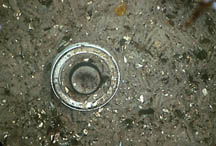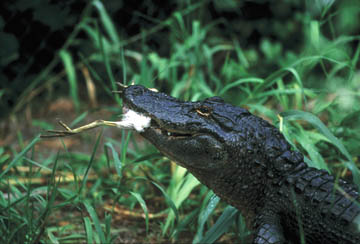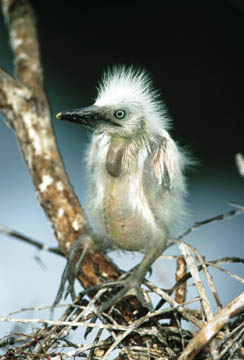Arthur Morris / Birds as Art
Bulletins and Notes Archive
Click any image to enlarge it
|
Bulletins and Notes Archive
|
BIRDS AS ART ON-LINE BULLETIN #51 July 19, 2001
St. Augustine IPT Tales
More on the flash disaster
Lens Cleaning Solution
On the first
morning of the recent St. Augustine Alligator Farm Instructional
Photo-Tour, I leaned over the edge of the boardwalk
to photograph a dying Tricolored Heron fledgling.
The was a loud
"kerplunk." Minutes before, I had placed my brand new Canon EF
1.4X II Teleconverter in an unzipped blouse pocket... I took it
well, saying simply to Joe Peters, "My 1.4X just joined the
alligators... Hey, stuff happens."
IPT
participant Linda Robbins graciously tried to extricate the TC
with a clamp on a pole that the staff provided. As the pole was
not very long, she stuck her arm between the bottom of the fence
and the boardwalk. A 12 foot gator promptly tried to remove her
arm a la the famous scene from Crocodile Dundee.
She valiantly
kept up her efforts until finally she snared the very wet TC.
As she slowly lifted it from the water, another gator chomped on
the wayward teleconverter.... He spit it right out, but at this
point we canceled any further salvage operations.
Here is the
TC's "last picture":

Four minutes
after I dropped the TC in the drink, Derrick MacDonald, who
had traveled from British Columbia to attend the IPT, let out
a scream, 'The gator's got one!" An eight foot gator had
snagged a fledgling Tricolored Heron. Several gators were
chasing him along the bank as he ran behind some small trees.
I grabbed the tripod-mounted 500mm IS lens and followed,
praying that when he stopped to swallow his breakfast that he
would stop in a clearing. He did. Here is my favorite image:

Photography
for the rest of the three days was excellent. Johan
Greyvensteyn, a South African native (Hi Cyril!), traveled all
the way from Korea where he lives and works to attend the
IPT. All in all, it was a really fun group.
There were
many Snowy and Cattle Egret nests with all stages of young.
Here is a Cattle Egret chick that is about three weeks old:

More on the Flash Disaster
After
consulting with several Canon tech reps and receiving a
detailed e-mail from Bulletin subscriber Edward Agnew, I have
just about concluded that the flash overexposure problem that
I encountered was NOT caused by damage to either of the flash
sensors on the front of the flash head. I shall share more of
this information with you in a future Bulletin and will
continue to try and figure out what went wrong. I used my new
flash with one of my two EOS 1vs this past weekend and will
keep all advised when I see the film. In any case, Better
Beamer users are urged to take great care when using the
beamer in sunny conditions.
Ellen Anon,
who will be assisting me on the upcoming Bosque and Florida
IPTs, wrote to remind me that during the field workshops this
past April at the National Zoo in Washington, DC, we nicknamed
the flash extender "The Better Burner."
From
Chile, IPT participant Alejandro Furman put a big smile on
my face when he wrote:
Hi Arthur:
Why could I never figure out where the charred and warped
black plastic on the front of my flash came from?
Why could I never see those strange Florida bugs that kept
biting my forearms but caused no after-itch?
Why could I never find any dead bees when slapping my
forehead after feeling the powerful sting when looking
through the viewfinder?
Why didn't I use my gray matter? Why did it take a
city-smart Jewish kid from N.Y. to put it all together for
me?
Best,
Alex
Lens Cleaning
Solution
I recently had the opportunity to try Eclipse Optical
Cleaning Solution and PEC*PADs. In a word, they worked
superbly, leaving the front elements of all my lenses
sparkling clean and lint- and streak-free.
To use, dispense several drops of the Eclipse Cleaning
solution onto a clean, folded Pec*Pad. Wipe the surface
of the lens until all (dirty) areas have been cleaned,
then slide the pad off of the glass from the center of the
lens' surface. Refold the pad to expose a clean side and
re-wipe as necessary. If streaks remain, use a clean,
fresh, dry Pec*Pad.
Distributor David M. Stone cautions:
The Eclipse is especially good at dissolving oily
residues, especially skin oils. No matter how clean or dry
you think your hands are, they ARE NOT ! Do not get the
oils from your hands all over a clean PEC*PAD. Take one
out of the bag by a corner only and be extra careful not
to touch the center area, especially when folding the pad.
If you are not careful, the Eclipse will dissolve the oils
nice and evenly on the pad and you will leave a
hazy, oily film on the front element of your lens.
For prices and details, contact:
David M. Stone
PHOTOGRAPHIC SOLUTIONS, INC.
http://www.photosol.com
(800) 637-3212 all US, all US territories & Canada
(508) 759-2322 phone (508) 759-9699 FAX
7 Granston Way Buzzards Bay, MA 02532
|
]
[
About Arthur
|
|
]
[ Photo-Tours
|
Books |
Photo Prints
]
[ Bulletin Archive
| FAQ
]
[
Accessories
|
Links ]
|